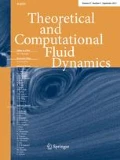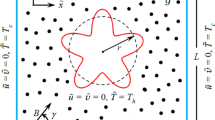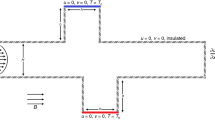Abstract
Thermomagnetic convection is based on the use of external magnetic fields to better control heat transfer fluxes in ferrofluids, finding important applications in engineering and many related areas. The improvement of such methods relies on fundamentally understanding the flow of ferrofluids under temperature gradients and external magnetic fields. However, the underlying physics of this phenomenon is very complex and not yet well characterized. The problem we analyze in this paper consists of a ferrofluid confined in a square cavity heated from the top and subjected to an external magnetic field applied in the horizontal direction. Differently from earlier investigations, this scenario leads to a clear competition between stabilizing gravitational forces and destabilizing magnetic forces; the unbalance between them drives the flow and dictates the mechanisms of heat transfer in the system. The problem is described by the equations of conservation of mass, momentum, and energy; both gravitational and magnetic effects are accounted for through the definition of the body force following the well-known Boussinesq approximation to express the ferrofluid’s density and magnetization as functions of temperature. The resulting set of fully coupled, nonlinear equations of the model is solved with a fully implicit finite element method. The results show that thermomagnetic convection increases convective heat transfer fluxes in the flow, but its net effects essentially depend on a complex balance among viscous, magnetic, and gravitational forces which determines the pattern of recirculation regions inside the cavity. There are two critical values associated with the external field’s intensity: the first marks the onset of thermomagnetic convection when the destabilizing magnetic effects become comparable to the stabilizing gravitational ones and the second corresponds to the external field’s strength that suffices to make the effects of gravity nearly negligible in the flow dynamics. The latter regime is dictated by a balance between viscous and magnetic forces only, and the corresponding numerical predictions agree notoriously well with a scaling analysis which suggests that \({\overline{\mathrm{Nu}}} \sim \mathrm{Ra}_\mathrm{m}^{1/4}\), where \({\overline{\mathrm{Nu}}}\) is the average Nusselt number at the isothermal walls and \(\mathrm{Ra}_\mathrm{m}\) is the magnetic Rayleigh number, a dimensionless parameter associated with the intensity of the external field.







Similar content being viewed by others
Notes
In general, the magnetic susceptibility is written as \(\chi = \chi (T,H)\), where \(H = ||{\varvec{H}}||\) is the intensity of the local magnetic field. Indeed, from the superparamagnetic theory for dilute ferrofluids [33], we have that \({\varvec{M}}= M_\mathrm{s} \mathcal {L}(\xi ) {\hat{{\varvec{H}}}}\), where \(M_\mathrm{s}\) is the saturation magnetization (that is, the maximum magnetization that can be achieved by the ferrofluid), \(\mathcal {L}(\xi ) = \coth (\xi ) - \xi ^{-1}\) is the Langevin function, and \({\hat{{\varvec{H}}}} = {\varvec{H}}/H\) is the unit vector along the direction of \({\varvec{H}}\). Here, \(\xi = \mu _0 mH/k_\mathrm{B} T\) is a dimensionless parameter that represents the ratio of magnetic-to-thermal energy, where m is the average intensity of the magnetic dipole of the suspended particles (which depends on their size and material) and \(k_\mathrm{B}\) is the Boltzmann constant. If the magnetic energy is much smaller than the thermal energy, which is the case considered herein, it follows that \(\xi \) is very small and the Langevin function can be approximated as \(\mathcal {L}(\xi ) \approx \xi /3\). Under this assumption, we have that \({\varvec{M}}= \chi (T){\varvec{H}}\) with \(\chi (T) = M_\mathrm{s} \mu _0 m/3k_\mathrm{B}T\).
In general, the local magnetic field is written as \({\varvec{H}}= {\varvec{H}}_\mathrm{e} + {\varvec{H}}_s\), where \({\varvec{H}}_s\) is the stray field (or demagnetizing field) that arises because of the interaction between the magnetization of the ferrofluid with the external magnetic field. However, if we assume that the saturation magnetization is much smaller than the external magnetic field, \({\varvec{H}}_s\) becomes negligible compared to \({\varvec{H}}_\mathrm{e}\) and hence \({\varvec{H}}\approx {\varvec{H}}_\mathrm{e}\). This approximation can be seen as a one-way coupling: the external magnetic field induces the ferrofluid flow, but the magnetic field created by the ferrofluid does not affect the external magnetic field in the flow domain.
The reference power-law curve used here is \({\overline{\hbox {Nu}}} = \exp [A\ln (\hbox {Ra}_\mathrm{m}) + B]\) with \(A \approx 0.2612\) and \(B \approx -1.5722\), obtained by fitting the results for \(\hbox {Ra} = 0\) in the range \(10^8 \le \hbox {Ra}_\mathrm{m} \le 10^9\).
References
Arpaci, V.S., Larsen, P.S.: Convection Heat Transfer. Prentice Hall, Upper Saddle River (1984)
Asfer, M., Mehta, B., Kumar, A., Khandekar, S., Panigrahi, P.K.: Effect of magnetic field on laminar convective heat transfer characteristics of ferrofluid flowing through a circular stainless steel tube. Int. J. Heat Fluid Flow 59, 74–86 (2016)
Ashouri, M., Shafii, M.B.: Numerical simulation of magnetic convection ferrofluid flow in a permanent magnet-inserted cavity. J. Magn. Magn. Mater. 442, 270–278 (2017)
Ashouri, M., Ebrahimi, B., Shafii, M.B., Saidi, M.H., Saidi, M.S.: Correlation for Nusselt number in pure magnetic convection ferrofluid flow in a square cavity by a numerical investigation. J. Magn. Magn. Mater. 322(22), 3607–3613 (2010)
Bahiraei, M., Hangi, M.: Flow and heat transfer characteristics of magnetic nanofluids: a review. J. Magn. Magn. Mater. 374, 125–138 (2015)
Belyaev, A.V., Smorodin, B.L.: The stability of ferrofluid flow in a vertical layer subject to lateral heating and horizontal magnetic field. J. Magn. Magn. Mater. 322(17), 2596–2606 (2010)
Berkovsky, B.M., Fertman, V.E., Polevikov, V.K., Isaev, S.V.: Heat transfer across vertical ferrofluid layers. Int. J. Heat Mass Transf. 19(9), 981–986 (1976)
Bozhko, A.A., Putin, G.F.: Heat transfer and flow patterns in ferrofluid convection. Magnetohydrodynamics 39(2), 147–169 (2003)
Braithwaite, D., Beaugnon, E., Tournier, R.: Magnetically controlled convection in a paramagnetic fluid. Nature 354(6349), 134–136 (1991)
Charles, S.W.: The preparation of magnetic fluids. In: Odenbach, S. (ed.) Ferrofluids: Magnetically Controllable Fluids and Their Applications, chap 1. Lectures Notes in Physics, vol. 594, pp. 3–18. Springer, Berlin (2002)
Cunha, F., Couto, H., Marcelino, N.: A study on magnetic convection in a narrow rectangular cavity. Magnetohydrodynamics 43(4), 421–428 (2007)
Cunha, L.H.P., Siqueira, I.R., Oliveira, T.F., Ceniceros, H.D.: Field-induced control of ferrofluid emulsion rheology and droplet break-up in shear flows. Phys. Fluids 30(12), 122110 (2018)
de Vahl, Davis G.: Natural convection of air in a square cavity: a bench mark numerical solution. Int. J. Numer. Methods Fluids 3(3), 249–264 (1983)
Duff, I.S., Erisman, A.M., Reid, J.K.: Direct Methods for Sparse Matrices. Oxford University Press, Oxford (1989)
Finlayson, B.A.: Convective instability of ferromagnetic fluids. J. Fluid Mech. 40(4), 753–767 (1970)
Ganguly, R., Sen, S., Puri, I.K.: Thermomagnetic convection in a square enclosure using a line dipole. Phys. Fluids 16(7), 2228–2236 (2004)
Genc, S., Derin, B.: Synthesis and rheology of ferrofluids: a review. Curr. Opin. Chem. Eng. 3, 118–124 (2014)
Gontijo, R.G., Cunha, F.R.: Experimental investigation on thermo-magnetic convection inside cavities. J. Nanosci. Nanotechnol. 12(12), 9198–9207 (2012)
Gui, N.G.J., Stanley, C., Nguyen, N.T., Rosengarten, G.: Ferrofluids for heat transfer enhancement under an external magnetic field. Int. J. Heat Mass Transf. 123, 110–21 (2018)
Kaloni, P.N., Lou, J.X.: Convective instability of magnetic fluids. Phys. Rev. E 70(2), 026313 (2004)
Kaloni, P.N., Lou, J.X.: Convective instability of magnetic fluids under alternating magnetic fields. Phys. Rev. E 71(6), 066311 (2005)
Kefayati, G.R.: Lattice boltzmann simulation of natural convection in nanofluid-filled 2D long enclosures at presence of magnetic field. Theor. Comput. Fluid Dyn. 27, 865–883 (2013)
Kikura, H., Sawada, T., Tanahashi, T.: Natural convection of a magnetic fluid in a cubic enclosure. J. Magn. Magn. Mater. 122(1–3), 315–318 (1993)
Kolchanov, N.V., Putin, G.F.: Gravitational convection of magnetic colloid in a horizontal layer. Int. J. Heat Mass Transf. 89, 90–101 (2015)
Krakov, M.S., Nikiforov, I.V.: To the influence of uniform magnetic field on thermomagnetic convection in square cavity. J. Magn. Magn. Mater. 252, 209–211 (2002)
Krakov, M.S., Nikiforov, I.V., Reks, A.G.: Influence of the uniform magnetic field on natural convection in cubic enclosure: experiment and numerical simulation. J. Magn. Magn. Mater. 289, 272–274 (2005)
Lewis, R.W., Nithiarasu, P., Seetharamu, K.N.: Fundamentals of the Finite Element Method for Heat and Fluid Flow. Wiley, New York (2004)
Mehta, J.S., Kumar, R., Kumar, H., Garg, H.: Convective heat transfer enhancement using ferrofluid: a review. J. Therm. Sci. Eng. Appl. 10(2), 020801 (2018)
Mukhopadhyay, A., Ganguly, R., Sen, S., Puri, I.K.: A scaling analysis to characterize thermomagnetic convection. Int. J. Heat Mass Transf. 48(17), 3485–3492 (2005)
Neuringer, J.L., Rosensweig, R.E.: Ferrohydrodynamics. Phys. Fluids 7(12), 1927–1937 (1964)
Nkurikiyimfura, I., Wang, Y., Pan, Z.: Heat transfer enhancement by magnetic nanofluids: a review. Renew. Sustain. Energy Rev. 21, 548–561 (2013)
Rahman, H., Suslov, S.A.: Magneto-gravitational convection in a vertical layer of ferrofluid in a uniform oblique magnetic field. J. Fluid Mech. 795, 847–875 (2016)
Rosensweig, R.E.: Ferrohydrodynamics. Cambridge University Press, Cambridge (1985)
Sawada, T., Kikura, H., Tanahashi, T.: Visualization of wall temperature distribution caused by natural convection of magnetic fluids in a cubic enclosure. Int. J. Appl. Electromagn. Mater. 4(4), 329–335 (1994)
Schwab, L., Hildebrandt, U., Stierstadt, K.: Magnetic Bénard convection. J. Magn. Magn. Mater. 39(1–2), 113–114 (1983)
Sheikholeslami, M., Rokni, H.B.: Simulation of nanofluid heat transfer in presence of magnetic field: a review. Int. J. Heat Mass Transf. 115, 1203–1233 (2017)
Sheikholeslami, M., Sadoughi, M.K.: Simulation of CuO–water nanofluid heat transfer enhancement in presence of melting surface. Int. J. Heat Mass Transf. 116, 909–919 (2018)
Sheikholeslami, M., Seyednezhad, M.: Nanofluid heat transfer in a permeable enclosure in presence of variable magnetic field by means of CVFEM. Int. J. Heat Mass Transf. 114, 1169–1180 (2017)
Sheikholeslami, M., Shehzad, S.A.: CVFEM for influence of external magnetic source on \({\rm Fe}_3{\rm O}_4-{\rm H}_2{\rm O}\) nanofluid behavior in a permeable cavity considering shape effect. Int. J. Heat Mass Transf. 115, 180–191 (2017)
Sheikholeslami, M., Shehzad, S.A.: Numerical analysis of \({\rm Fe}_3{\rm O}_4-{\rm H}_2{\rm O}\) nanofluid flow in permeable media under the effect of external magnetic source. Int. J. Heat Mass Transf. 118, 182–192 (2018)
Sheikholeslami, M., Hayat, T., Alsaedi, A.: On simulation of nanofluid radiation and natural convection in an enclosure with elliptical cylinders. Int. J. Heat Mass Transf. 115, 981–991 (2017)
Sheikholeslami, M., Gerdroodbary, M.B., Mousavi, S.V., Ganji, D.D., Moradi, R.: Heat transfer enhancement of ferrofluid inside an 90\(^{\circ }\) elbow channel by non-uniform magnetic field. J. Magn. Magn. Mater. 460, 302–311 (2018)
Shliomis, M.I., Smorodin, B.L.: Convective instability of magnetized ferrofluids. J. Magn. Magn. Mater. 252, 197–202 (2002)
Snyder, S.M., Cader, T., Finlayson, B.A.: Finite element model of magnetoconvection of a ferrofluid. J. Magn. Magn. Mater. 262(2), 269–279 (2003)
Suslov, S.A., Bozhko, A.A., Sidorov, A.S., Putin, G.F.: Thermomagnetic convective flows in a vertical layer of ferrocolloid: perturbation energy analysis and experimental study. Phys. Rev. E 86(1), 016301 (2012)
Szabo, P.S.B., Früh, W.G.: The transition from natural convection to thermomagnetic convection of a magnetic fluid in a non-uniform magnetic field. J. Magn. Magn. Mater. 447, 116–123 (2018)
Tangthieng, C., Finlayson, B.A., Maulbetsch, J., Cader, T.: Heat transfer enhancement in ferrofluids subjected to steady magnetic fields. J. Magn. Magn. Mater. 201(1–3), 252–255 (1999)
Torres-Díaz, I., Rinaldi, C.: Recent progress in ferrofluids research: novel applications of magnetically controllable and tunable fluids. Soft Matter 10(43), 8584–8602 (2014)
Vatani, A., Woodfield, P.L., Nguyen, N.T., Abdollahi, A., Dao, D.V.: Numerical simulation of combined natural and thermomagnetic convection around a current carrying wire in ferrofluid. J. Magn. Magn. Mater. 489, 165383 (2019)
Wang, J., Li, G., Zhu, H., Luo, J., Sundén, B.: Experimental investigation on convective heat transfer of ferrofluids inside a pipe under various magnet orientations. Int. J. Heat Mass Transf. 132, 407–419 (2019)
Wrobel, W., Fornalik-Wajs, E., Szmyd, J.: Experimental and numerical analysis of thermo-magnetic convection in a vertical annular enclosure. Int. J. Heat Fluid Flow 31(6), 1019–1031 (2010)
Yamaguchi, H., Kobori, I., Uehata, Y.: Heat transfer in natural convection of magnetic fluids. J. Thermophys. Heat Transf. 13(4), 501–507 (1999a)
Yamaguchi, H., Kobori, I., Uehata, Y., Shimada, K.: Natural convection of magnetic fluid in a rectangular box. J. Magn. Magn. Mater. 201(1–3), 264–267 (1999b)
Funding
was provided by Conselho Nacional de Desenvolvimento Científico e Tecnológico (BR) (Grant No. 303835/2018-4).
Author information
Authors and Affiliations
Corresponding author
Additional information
Communicated by Oleg Zikanov.
Publisher's Note
Springer Nature remains neutral with regard to jurisdictional claims in published maps and institutional affiliations.
Lucas H. P. Cunha, Ivan R. Siqueira, and Arthur A. R. Campos have contributed equally to this work.
Rights and permissions
About this article
Cite this article
Cunha, L.H.P., Siqueira, I.R., Campos, A.A.R. et al. A numerical study on heat transfer of a ferrofluid flow in a square cavity under simultaneous gravitational and magnetic convection. Theor. Comput. Fluid Dyn. 34, 119–132 (2020). https://doi.org/10.1007/s00162-020-00515-1
Received:
Accepted:
Published:
Issue Date:
DOI: https://doi.org/10.1007/s00162-020-00515-1




